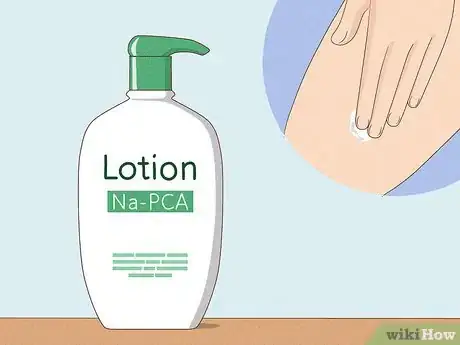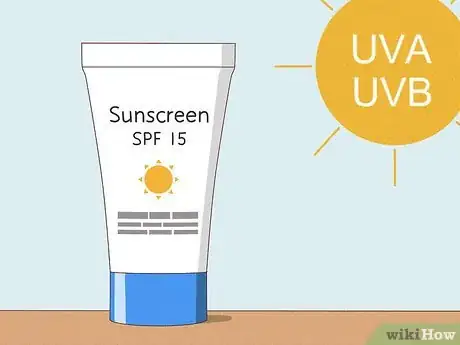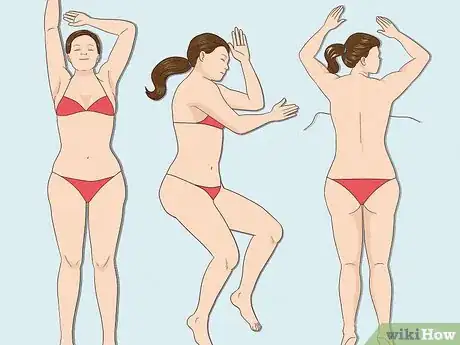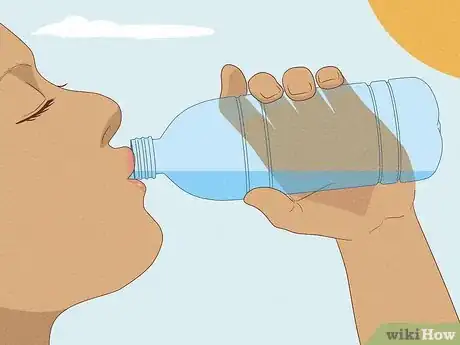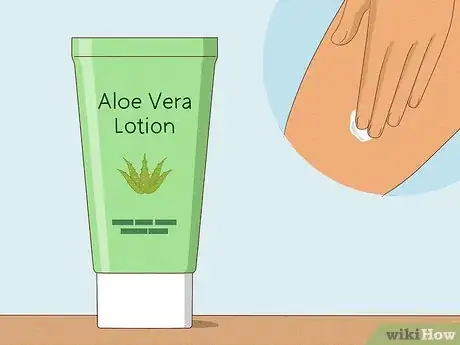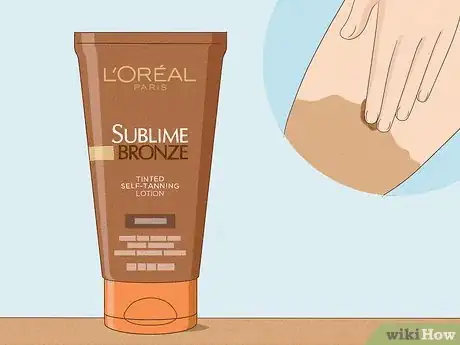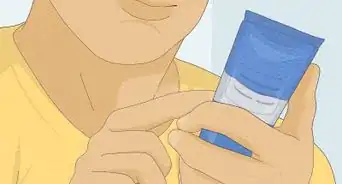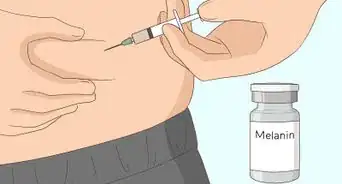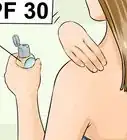This article was co-authored by Chloe Goldman. Dr. Chloe Goldman, MD is a Dermatologist based in Miami, Florida, who currently works at Baumann Cosmetic & Research Institute and Upper East Side Dermatology. She specializes in cosmetic, medical, and surgical dermatology. She earned a Doctor of Medicine from New York University and a BA in Biology, Neurobiology, and Behavior from Cornell University. She completed her dermatology training at University of Miami, where she was awarded the prestigious position of Chief Resident. She has won grants from the American Skin Foundation and the Melanoma Research Foundation.
There are 10 references cited in this article, which can be found at the bottom of the page.
wikiHow marks an article as reader-approved once it receives enough positive feedback. This article has 19 testimonials from our readers, earning it our reader-approved status.
This article has been viewed 2,771,275 times.
People tend to look great when they have a bit of a tan—it adds a warm glow to the skin, masks blemishes, and helps make colorful clothes stand out. It can be tricky business, getting the right tan—there are UV rays to worry about, awkward orange colors to avoid, and tan lines to consider. With a little knowledge and forethought, you can overcome any obstacles, and get that tan you're looking for—and we'll show you how. Follow these simple steps and get that golden glow in short order!
Steps
Fun in the Sun
-
1Choose your UV source. For ultraviolet tanning, nothing beats good, old-fashioned sunshine. If your skies or weather don't permit, though, tanning beds are an effective, year-round alternative to keep your skin lightly browned.
- Keep it all in moderation—great looking skin can end up looking like leather if you stay in the "oven" too long.
-
2Hydrate your skin. Skin that's well hydrated will tan better than dusty, dry skin. Before you do prepare your skin to tan well, do the following:
- In the shower, exfoliate dry, dead epidermal cells by scrubbing gently with a rough cloth, loofah, or exfoliating soap.[1]
- Moisturize your skin with a lotion containing sodium PCA. It's a naturally-occurring component of human skin that helps maintain a healthy epidermis, and works by attracting moisture from the air.[2]
- Apply the right level of sunscreen for your skin. If you have light skin, use a lotion with a higher SPF rating than if you have darker skin. No matter what your skin type or how much base you have built up, always use a sunscreen with at least an SPF rating of 15.[3]
- If you are going to be in the water, make sure your sunscreen is waterproof, or re-apply when you're out of the water. Otherwise, re-apply sunscreen as directed on the label—usually every couple hours.
Advertisement -
3Wear sunscreen when you tan! If you are just going to sit on the beach and tan for an hour put SPF 4-15 on, depending on how fair your complexion is and how much base you've already built up.[4]
- If you don't use sunscreen while tanning, UVA and UVB rays can still harm your skin, even if you don't get burned!
- Use lip balm with sunscreen as well. Ideally, apply your sunscreen in the shade, and let it soak in for 20-25 minutes before you go into the sun. Reapply as needed if you go swimming and the sunscreen is not waterproof, or every couple hours as directed on the label.
- If you notice redness developing on your skin, get out of the light—you're already burned, and continuing to bake will only deepen the burn and increase your risk of serious damage.
-
4(Un)dress for success. Unless you want a patchwork quilt of tan lines, wear the swimsuit you will wear when you are swimming! Wearing the same swimsuit will give you a smooth, buttery tan that flows from skin to bathing suit.
- Skip the swimsuit altogether if you can. The only thing better than minimal tan lines is no tan lines at all!
-
5Find your place in the sun. You can tan in your own backyard, at the beach, or anywhere that the sun shines. All you need is your tanning lotion, water, and a beach chair or towel.
- Position the chair or towel in the yard where the sun will hit you directly.
-
6Move while you tan. Think "rotisserie chicken." To get that great, all-over browning, you have to keep on the move. Front, back, sides, and places where the sun doesn't normally shine—like underarms.Or spend one day on your backside and one day on your frontside
- If you don't want to lie around all day, but still want that tan, another alternative is to go for a jog, or even a walk. This not only increases your sun exposure and increases your tan but helps give you a slim, toned body at the same time. Nice!
-
7Protect your eyes. They can be burned, too. For tanning, though, it's better to either wear a hat or just keep your eyes closed rather than wear sunglasses. Bright light on your optic nerve stimulates the hypothalamus gland, which in turn causes the production of melanin, thus achieving a deeper tan.[5]
-
8Hydrate! Make sure you drink plenty of water. Jump in the pool to cool yourself down now and then, too. Don't worry, this will not harm your tanning in the least. Don't forget to re-apply your sunscreen afterwards.
-
9After you tan, moisturize. Use an aloe-based skin lotion to sooth and moisturize your skin. It will help keep your skin healthy and will prevent it from becoming flaky and dry from the sun.
Rub In Your Tan
-
1Skip the sun. If you're very fair, tend to burn easily, or want to minimize the health risks, sun tanning or UV tanning beds might be exactly the wrong choice. You won't know you're burning until after you're burned and the damage is already done.
-
2Do it yourself. There are a variety of products from companies such as Neutrogena, L'Oreal, Victoria's Secret, and many more, that will give you a smooth, even tan.
- As per the instructions, apply the lotion or spray evenly, taking care to get all skin covered. The best lotions will be non comedogenic, which means it won't clog your pores.
- Unless you have unusually long arms or are exceedingly flexible, you'll want a friend to help you get your back covered.
- It's a good idea to use a scrub with exfoliating microbeads in it to remove the fake tanner from your skin afterwards.
- Exfoliate your skin after the treatment using a product that contains glycolic acid to help kind of facilitate the process.
-
3Shed your inhibitions. Visit a tanning salon, and let them do an all-over tan. In just a few minutes, they'll professionally apply a tanning mist over your entire body.
-
4Read the label. Before you plunk down your cash, read the various reviews available on both product and on service—watch out for spray-on tans that turn you orange.
Community Q&A
-
QuestionDoes coconut oil help you tan faster?
 Community AnswerYes, it does help you tan faster. It is an oil which will amplify the sun's effects. Don't overdo the tanning though, as you can easily get sunburn.
Community AnswerYes, it does help you tan faster. It is an oil which will amplify the sun's effects. Don't overdo the tanning though, as you can easily get sunburn. -
QuestionHow long should I spend on each side?
 Community AnswerAbout 15 to 30 minutes on each side depending on how fair your skin is and how easily you burn.
Community AnswerAbout 15 to 30 minutes on each side depending on how fair your skin is and how easily you burn. -
QuestionHow long should I stay outside if I burn easily?
 Community AnswerLimit your sun exposure to only 15 or 30 minutes before going into the shade; you can always return to the sun later once you skin has had some time to recover. Remember to wear a lot of sunscreen before going out into the sun, and always use moisturizer afterwards.
Community AnswerLimit your sun exposure to only 15 or 30 minutes before going into the shade; you can always return to the sun later once you skin has had some time to recover. Remember to wear a lot of sunscreen before going out into the sun, and always use moisturizer afterwards.
Warnings
- Remember that while you tan, and after you come inside, drink lots of water. If your skin feels hot, try an after sun lotion to cool it down as a shower might sting if you have been burnt.⧼thumbs_response⧽
- If you stay out in the sun too long, you could be in danger of heatstroke.[6]⧼thumbs_response⧽
- If you get burned and feel really tired after tanning, you may have sun poisoning.[7]⧼thumbs_response⧽
- Tanning beds can damage your skin and may increase your risk of skin cancer.[8]⧼thumbs_response⧽
- Beware of tanning pills; numerous cases of crystallized deposits in the eyes have been noted in persons using tanning pills. These deposits have been found to eventually lead to blindness.[9]⧼thumbs_response⧽
- Keep track of any moles, and watch for changes in color or shape.[10]⧼thumbs_response⧽
- Sunburns can be anywhere from mild to moderate. If you get a severe burn, see a doctor.[11]⧼thumbs_response⧽
- Extensive tanning or exposure to UV radiation may lead to skin cancer, which in its worst form is called Melanoma. Using a spray tan is safer. If you must be tanned and don't care if you turn slightly orange, you could save your life.[12]⧼thumbs_response⧽
References
- ↑ https://www.medicaldaily.com/four-safe-tanning-tips-healthy-summer-glow-246439
- ↑ https://cosmeticsinfo.org/ingredient/sodium-pca
- ↑ https://www.medicaldaily.com/four-safe-tanning-tips-healthy-summer-glow-246439
- ↑ https://www.medicaldaily.com/four-safe-tanning-tips-healthy-summer-glow-246439
- ↑ https://scienceline.org/2007/06/ask-dricoll-inuiteskimos/
- ↑ https://www.mayoclinic.org/diseases-conditions/heat-stroke/symptoms-causes/syc-20353581
- ↑ https://www.webmd.com/skin-problems-and-treatments/sun-poisoning#1
- ↑ https://www.melanoma.org/understand-melanoma/preventing-melanoma/why-is-tanning-dangerous
- ↑ https://www.cancer.org/cancer/skin-cancer/prevention-and-early-detection/tanning-pills-and-products.html
- ↑ https://www.skincancer.org/skin-cancer-information/atypical-moles/warning-signs-and-images
- ↑ https://www.webmd.com/skin-problems-and-treatments/sun-poisoning#1
- ↑ https://www.melanoma.org/understand-melanoma/preventing-melanoma/why-is-tanning-dangerous
- Encyclopedia Britannica
- Skin Deep Cosmetics Guide
About This Article
Before you get a tan, exfoliate with a loofah or cloth and hydrate your skin with a good lotion. If you are tanning outside, apply an SPF 15 sunscreen to any exposed skin, which will protect your skin from harmful rays while you tan. Then, if you want to tan outside, lay on the beach or in your backyard, but make sure to move every 10-15 minutes so you will get an even tan. If you have fair skin or burn easily, skip the direct sunlight and use a tanning lotion or visit a spray-on tanning salon instead. For more tips on getting a youthful summer glow without damaging your skin, scroll down!

